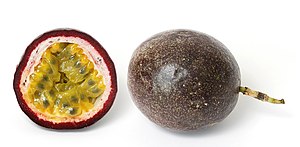Cookbook:Passion Fruit
| Passion Fruit | |
|---|---|
 | |
| Category | Fruits |
Cookbook | Recipes | Ingredients | Equipment | Techniques | Cookbook Disambiguation Pages | Ingredients | Fruit
Passion fruit is a goop-filled tropical fruit. You're actually supposed to eat the seedy goop and throw away the outer part, not the other way around. The other strange thing is that wrinkled dehydrated-looking ones are considered best.
The seeds are edible so you can eat the orange goop straight from the shell. Passion fruit is more commonly sieved and its highly aromatic pulp and juice are used as a flavoring for beverages and sauces. The pulp has an intense aromatic flavor, while the texture is jelly-like and watery. The flavor is likened to guava. Native to Brazil, passion fruits are grown in Hawaii, Florida, and California. These crops, along with imports from New Zealand, keep passion fruit on the market all year.
Selection
editChoose large, heavy, firm fruit. When ripe, it has wrinkled, dimpled, and often deep purple skin. Some fruit, particularly that of Hawaii, is yellow when ripe. Skin is old-looking, but does not mean the fruit is rotten. Mold does not affect quality and can be wiped off. Fruit color is green when they are immature, changing to shades of purple, red or yellow as they ripen. Leave at room temperature to ripen. The skin will wrinkle, but the fruit will not soften much. Once ripe, store in the refrigerator up to 1 week.
Preparation
editPassion Fruit is generally eaten fresh but may be cooked for use in sauces and fillings. Begin by cutting the fruit in half and scooping out the fleshy pulp with a spoon. Spoon the pulp over ice cream or other soft fruits. The pulp makes a delicious jam or jelly and the seeds add a unique crunchy texture. To remove seeds: Strain in a non-aluminum sieve, or use cheesecloth, squeezing to extract the juice.